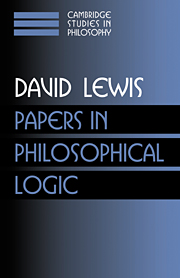Book contents
- Frontmatter
- Contents
- Dedication
- Introduction
- 1 Adverbs of quantification
- 2 Index, context, and content
- 3 ‘Whether’ report
- 4 Probabilities of conditionals and conditional probabilities II
- 5 Intensional logics without iterative axioms
- 6 Ordering semantics and premise semantics for counterfactuals
- 7 Logic for equivocators
- 8 Relevant implication
- 9 Statements partly about observation
- 10 Ayer's first empiricist criterion of meaning: why does it fail?
- 11 Analog and digital
- 12 Lucas against mechanism
- 13 Lucas against mechanism II
- 14 Policing the Aufbau
- 15 Finitude and infinitude in the atomic calculus of individuals (with Wilfrid Hodges)
- 16 Nominalistic set theory
- 17 Mathematics is megethology
- Index
11 - Analog and digital
Published online by Cambridge University Press: 05 June 2012
- Frontmatter
- Contents
- Dedication
- Introduction
- 1 Adverbs of quantification
- 2 Index, context, and content
- 3 ‘Whether’ report
- 4 Probabilities of conditionals and conditional probabilities II
- 5 Intensional logics without iterative axioms
- 6 Ordering semantics and premise semantics for counterfactuals
- 7 Logic for equivocators
- 8 Relevant implication
- 9 Statements partly about observation
- 10 Ayer's first empiricist criterion of meaning: why does it fail?
- 11 Analog and digital
- 12 Lucas against mechanism
- 13 Lucas against mechanism II
- 14 Policing the Aufbau
- 15 Finitude and infinitude in the atomic calculus of individuals (with Wilfrid Hodges)
- 16 Nominalistic set theory
- 17 Mathematics is megethology
- Index
Summary
The distinction between analog and digital representation of numbers is well understood in practice. Yet its analysis has proved troublesome. I shall first consider the account given by Nelson Goodman and offer examples to show that some cases of analog representation are mis-classified, on Goodman's account, as digital. Then I shall offer alternative analyses of analog and digital representation.
DIFFERENTIATED ANALOG REPRESENTATION
According to Goodman in Languages of Art, the distinction between digital and analog representation of numbers is as follows. Digital representation is differentiated. Given a number-representing “mark” – an inscription, vocal utterance, pointer position, electrical pulse, or whatever – it is theoretically possible, despite our inability to make infinitely precise measurements, to determine exactly which other marks are copies of the given mark and to determine exactly which number (or numbers) the given mark and its copies represent. Analog representation, on the other hand, fails to be differentiated because it is dense. For any two marks that are not copies, no matter how nearly indistinguishable they are, there could be a mark intermediate between them which is a copy of neither; and for any two marks that are not copies and represent different numbers, no matter how close the numbers are, there is an intermediate number which would be represented by a mark that is a copy of neither.
It is true and important that digital representation is differentiated, and that it differs thereby from the many cases of analog representation that are undifferentiated and dense: those cases in which all real numbers in some range are represented by values of some continuously variable physical magnitude such as voltage.
- Type
- Chapter
- Information
- Papers in Philosophical Logic , pp. 159 - 165Publisher: Cambridge University PressPrint publication year: 1997



